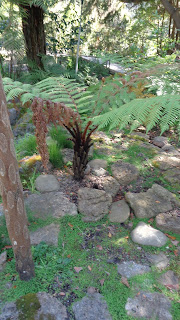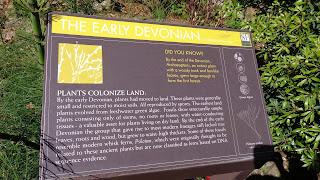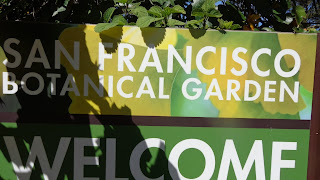The San Francisco Botanical Garden (formerly Strybing Arboretum) is located in San Francisco's Golden Gate Park.
Its 55 acres (22.3 ha) include over 50,000 individual plants,
representing over 8,000 taxa from around the world, with particular
focus on Magnolia species, high elevation palms, and cloud forest species from Central America, South America and Southeast Asia
History


Plans for the garden were originally laid out in the 1880s by park supervisor John McLaren, but funding was insufficient to begin construction until Helene Strybing left a major bequest in 1927. Planting was begun in 1937 with WPA funds supplemented by local donations, and the arboretum officially opened in May 1940.

As a part of Golden Gate Park, it is officially managed by the city of San Francisco, but the San Francisco Botanical Garden Society plays an important role in providing educational programs, managing volunteers, and curatorial staff.


Formed in 1955, the San Francisco Botanical Garden Society (formerly the Strybing Arboretum Society) operates the Helen Crocker Russell Library of Horticulture, a bookstore, and monthly plant sales, and offers a wide range of community education programs for children and adults.

The Society also raises money for new projects and Garden renovations. Using green building practices, a new Center for Sustainable Gardening is planned to replace the existing nursery. Other planned renovations include a Southeast Asian Cloud Forest and newly paved pathways.


The Garden continues to actively acquire plants; in 2009 it received 865 accessions totaling over 4,100 individual plants.


Having changed its name from Strybing Arboretum to match that of the San Francisco Botanical Garden Society, the name was changed to San Francisco Botanical Garden Society at Strybing Arboretum and recent signage has dropped the reference to Helene Strybing.


Among the many beautiful spaces within San Francisco Botanical Garden, the Redwood Grove is consistently cited as a favorite among visitors who are surprised to find that they don't have to leave the City to see these venerable trees.

This century-old grove is full of the fog-loving towering giants known as Coast Redwoods or Sequoia sempervirens. Their magnificent height creates an otherworldly sanctuary filled with lush shade-loving understory plants like sword ferns, flowering currant, and huckleberry.


One of the most remarkable and unique plant communities in the world, the collection of Sequoia sempervirens represents the key species in this very special coastal plant community.


These trees are the tallest living things on Earth and among the most well-adapted to their growing conditions. Stands of old-growth coast redwoods once flourished on more than two million acres but have been reduced by extensive logging during the last 150 years.


The coast redwoods at San Francisco Botanical Garden were planted around the turn of the 20th century and are among the oldest trees in the Botanical Garden. More than 100 species of associated plants have been added over the past 40 years to represent a typical redwood forest community

Rhododendron occidentale is one of the West Coast's showiest shrubs. Native to California and Southwestern Oregon, it can be found in a variety of habitats from foggy coastal scrub to coast redwood forests as well as in serpentine soils.


First reported in a publication by Sir William Hooker in 1857, the discovery of the western azalea dates back to the 1820s.

Western azalea's flowers are funnel-shaped and typically four inches long, two to three inches wide and wonderfully fragrant. The corolla has five lobes (petals) generally white to deep rosy pink with an yellow-orange blotched marking on the inside of the upper lobe. New foliage emerges a bright glossy green and, along with buds, pedicels and seed capsules are covered with oil glands that fall off during the season.


Western azalea is deciduous, and in autumn the leaves turn golden-yellow before falling. They can reach five to 15 feet but are slow growing and often challenging to grow in cultivation. In growing the western azalea over the years, we have learned that providing routine moisture and a cool, protected root zone is critical to its success.




Ancient Plant Garden


What is old is new again, and again, thanks to evolution. One of the most visceral and enjoyable ways to experience time unfolding is in our Ancient Plant Garden.


Tunnel your vision from any number of purviews here and you can imagine dinosaurs grazing just beyond the fern fronds.


Many non-extinct living plant groups are represented in this garden, some of which are known as 'living fossils.'
 The layout of the Ancient Plant Garden allows visitors to move
chronologically through five periods or epochs: Early Devonian,
Pennsylvanian, Jurassic, Cretaceous, and Eocene.
The layout of the Ancient Plant Garden allows visitors to move
chronologically through five periods or epochs: Early Devonian,
Pennsylvanian, Jurassic, Cretaceous, and Eocene.


Low growing simple plants like Chara (green alga), Angiopteris and Osmunda (fern) represent the early Devonian epoch. Pennsylvanian plants represent a time when plants started growing to tree size, plants like, Equisetum myriochaetum, E. gigantum (horsetail), and Dicksonia (tree fern).


The Jurassic epoch was when seed plants began to dominate. Here we begin to see Podocarpus, Araucaria, Cycas (Cycads) and Agathis. During the Cretaceous period angiosperms (flowering plants) started to appear including Illicium, Aristolochia, and Nymphaea (water lily).

Finally in the Eocene epoch angiosperms dominated and leaf size grew due to a warm, moist climate. Magnolia, Mahonia, Ranunculaceae (buttercup family) and Zingiberaceae (ginger family) are all representative of this time period.


The Chilean Garden was among the original collections that opened the Garden in 1940. Nestled next to the Andean Cloud Forest, this small but important garden has seen upgrades and renovation in recent years.


Some of its special attributes include a mass planting of over 10 Chilean wine palms (Jubaea chilensis) at the entrance alongside different Puya species and a small grove of Chilean myrtle (Luma apiculata) with vibrant tan-orange bark that stands in dramatic contrast to the deep green glossy leaves.

The Andean Cloud Forest, currently under renovation, grew from SFBG's close relationship with the Botany Department at the California Academy of Sciences, in particular Senior Curator of Botany, Frank Almeda. Dr. Almeda has been traveling to South America for over 10 years to study the Melastomataceae family, many of which grow in cloud forest habitats. Over the years, Frank has shared seed with SFBGS Curator Dr. Don Mahoney, to grow our collection of Andean Cloud Forest plants.

Along with the Mesoamerican and Southeast Asian cloud forest gardens, the Andean Cloud Forest collection represents a key biodiversity hotspot of plants rapidly disappearing in the wild.
The cornerstone of the Andean Cloud Forest Garden is the most comprehensive collection of high elevation palm species known in any botanical garden in the world.


There are new and established high-elevation palms in our collection, including Ceroxylon quindiuense (Andean wax palm), the tallest palm in the world, from the Colombian Andes. Our specimens were planted in 1980, and are still in juvenile form at 60 feet.

The tallest Ceroxylon quindiuense on record in Colombia has reached over 200 feet. More recent palm plantings include Parajubaea torallyi, the highest-elevation palm that grows at 11,000 feet in the Bolivian Andes.



History


Plans for the garden were originally laid out in the 1880s by park supervisor John McLaren, but funding was insufficient to begin construction until Helene Strybing left a major bequest in 1927. Planting was begun in 1937 with WPA funds supplemented by local donations, and the arboretum officially opened in May 1940.

As a part of Golden Gate Park, it is officially managed by the city of San Francisco, but the San Francisco Botanical Garden Society plays an important role in providing educational programs, managing volunteers, and curatorial staff.


Formed in 1955, the San Francisco Botanical Garden Society (formerly the Strybing Arboretum Society) operates the Helen Crocker Russell Library of Horticulture, a bookstore, and monthly plant sales, and offers a wide range of community education programs for children and adults.

The Society also raises money for new projects and Garden renovations. Using green building practices, a new Center for Sustainable Gardening is planned to replace the existing nursery. Other planned renovations include a Southeast Asian Cloud Forest and newly paved pathways.


The Garden continues to actively acquire plants; in 2009 it received 865 accessions totaling over 4,100 individual plants.


Having changed its name from Strybing Arboretum to match that of the San Francisco Botanical Garden Society, the name was changed to San Francisco Botanical Garden Society at Strybing Arboretum and recent signage has dropped the reference to Helene Strybing.


Among the many beautiful spaces within San Francisco Botanical Garden, the Redwood Grove is consistently cited as a favorite among visitors who are surprised to find that they don't have to leave the City to see these venerable trees.

This century-old grove is full of the fog-loving towering giants known as Coast Redwoods or Sequoia sempervirens. Their magnificent height creates an otherworldly sanctuary filled with lush shade-loving understory plants like sword ferns, flowering currant, and huckleberry.


One of the most remarkable and unique plant communities in the world, the collection of Sequoia sempervirens represents the key species in this very special coastal plant community.


These trees are the tallest living things on Earth and among the most well-adapted to their growing conditions. Stands of old-growth coast redwoods once flourished on more than two million acres but have been reduced by extensive logging during the last 150 years.


The coast redwoods at San Francisco Botanical Garden were planted around the turn of the 20th century and are among the oldest trees in the Botanical Garden. More than 100 species of associated plants have been added over the past 40 years to represent a typical redwood forest community

Rhododendron occidentale is one of the West Coast's showiest shrubs. Native to California and Southwestern Oregon, it can be found in a variety of habitats from foggy coastal scrub to coast redwood forests as well as in serpentine soils.


First reported in a publication by Sir William Hooker in 1857, the discovery of the western azalea dates back to the 1820s.

Western azalea's flowers are funnel-shaped and typically four inches long, two to three inches wide and wonderfully fragrant. The corolla has five lobes (petals) generally white to deep rosy pink with an yellow-orange blotched marking on the inside of the upper lobe. New foliage emerges a bright glossy green and, along with buds, pedicels and seed capsules are covered with oil glands that fall off during the season.


Western azalea is deciduous, and in autumn the leaves turn golden-yellow before falling. They can reach five to 15 feet but are slow growing and often challenging to grow in cultivation. In growing the western azalea over the years, we have learned that providing routine moisture and a cool, protected root zone is critical to its success.


Mediterranean Climate
Characterized by warm dry summers and mild wet winters, this climate is similar to that of San Francisco and is found in five major locations around the world, namely in Coastal California, Central Chile, the Cape Province of South Africa, Southwest Australia, and the lands around the Mediterranean Sea. Plants from this climate are an emphasis of the Botanical Garden.
California Native Plants
April and May are the best times to experience California natives at the peak of their bloom. Take in bright blue wild lilac amidst a carpet of meadowfoam, iris, poppies and other amazing plants in the Arthur L. Menzies Garden of California Native Plants.
Ancient Plant Garden


What is old is new again, and again, thanks to evolution. One of the most visceral and enjoyable ways to experience time unfolding is in our Ancient Plant Garden.


Tunnel your vision from any number of purviews here and you can imagine dinosaurs grazing just beyond the fern fronds.


Many non-extinct living plant groups are represented in this garden, some of which are known as 'living fossils.'
 The layout of the Ancient Plant Garden allows visitors to move
chronologically through five periods or epochs: Early Devonian,
Pennsylvanian, Jurassic, Cretaceous, and Eocene.
The layout of the Ancient Plant Garden allows visitors to move
chronologically through five periods or epochs: Early Devonian,
Pennsylvanian, Jurassic, Cretaceous, and Eocene. 

Low growing simple plants like Chara (green alga), Angiopteris and Osmunda (fern) represent the early Devonian epoch. Pennsylvanian plants represent a time when plants started growing to tree size, plants like, Equisetum myriochaetum, E. gigantum (horsetail), and Dicksonia (tree fern).


The Jurassic epoch was when seed plants began to dominate. Here we begin to see Podocarpus, Araucaria, Cycas (Cycads) and Agathis. During the Cretaceous period angiosperms (flowering plants) started to appear including Illicium, Aristolochia, and Nymphaea (water lily).

Finally in the Eocene epoch angiosperms dominated and leaf size grew due to a warm, moist climate. Magnolia, Mahonia, Ranunculaceae (buttercup family) and Zingiberaceae (ginger family) are all representative of this time period.


The Chilean Garden was among the original collections that opened the Garden in 1940. Nestled next to the Andean Cloud Forest, this small but important garden has seen upgrades and renovation in recent years.


Some of its special attributes include a mass planting of over 10 Chilean wine palms (Jubaea chilensis) at the entrance alongside different Puya species and a small grove of Chilean myrtle (Luma apiculata) with vibrant tan-orange bark that stands in dramatic contrast to the deep green glossy leaves.

The Andean Cloud Forest, currently under renovation, grew from SFBG's close relationship with the Botany Department at the California Academy of Sciences, in particular Senior Curator of Botany, Frank Almeda. Dr. Almeda has been traveling to South America for over 10 years to study the Melastomataceae family, many of which grow in cloud forest habitats. Over the years, Frank has shared seed with SFBGS Curator Dr. Don Mahoney, to grow our collection of Andean Cloud Forest plants.

Along with the Mesoamerican and Southeast Asian cloud forest gardens, the Andean Cloud Forest collection represents a key biodiversity hotspot of plants rapidly disappearing in the wild.
The cornerstone of the Andean Cloud Forest Garden is the most comprehensive collection of high elevation palm species known in any botanical garden in the world.


There are new and established high-elevation palms in our collection, including Ceroxylon quindiuense (Andean wax palm), the tallest palm in the world, from the Colombian Andes. Our specimens were planted in 1980, and are still in juvenile form at 60 feet.

The tallest Ceroxylon quindiuense on record in Colombia has reached over 200 feet. More recent palm plantings include Parajubaea torallyi, the highest-elevation palm that grows at 11,000 feet in the Bolivian Andes.


ADMISSION
FREE for Members, SF Residents (with proof of residency) & School
Groups | $8 Non-residents | Discounts for Seniors, Families &
Children
LOCATED
In Golden Gate Park, with entrances at the corner of Ninth Ave. at
Lincoln Way (Main Gate) & at MLK Jr. Drive off the Music Concourse
(Friend/North Gate) | Phone: (415) 661-1316 | Mail: 1199 9th Ave, San
Francisco, CA 94122-2370














































No comments:
Post a Comment